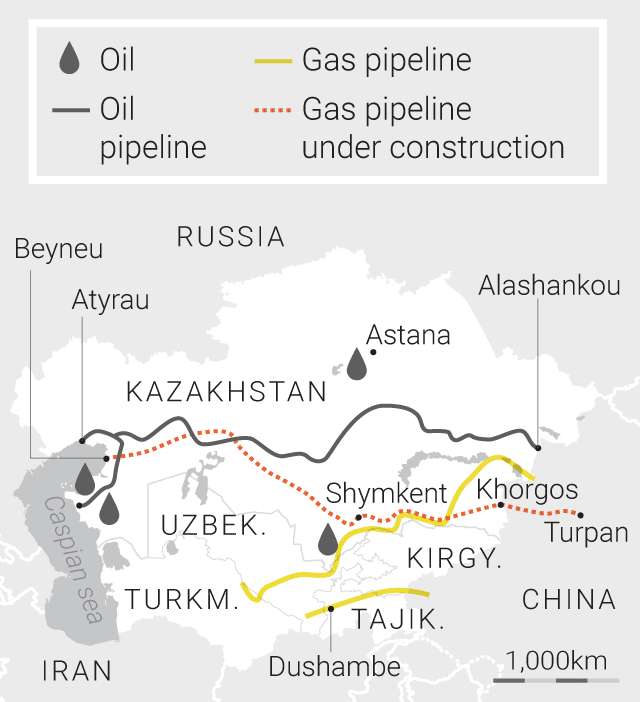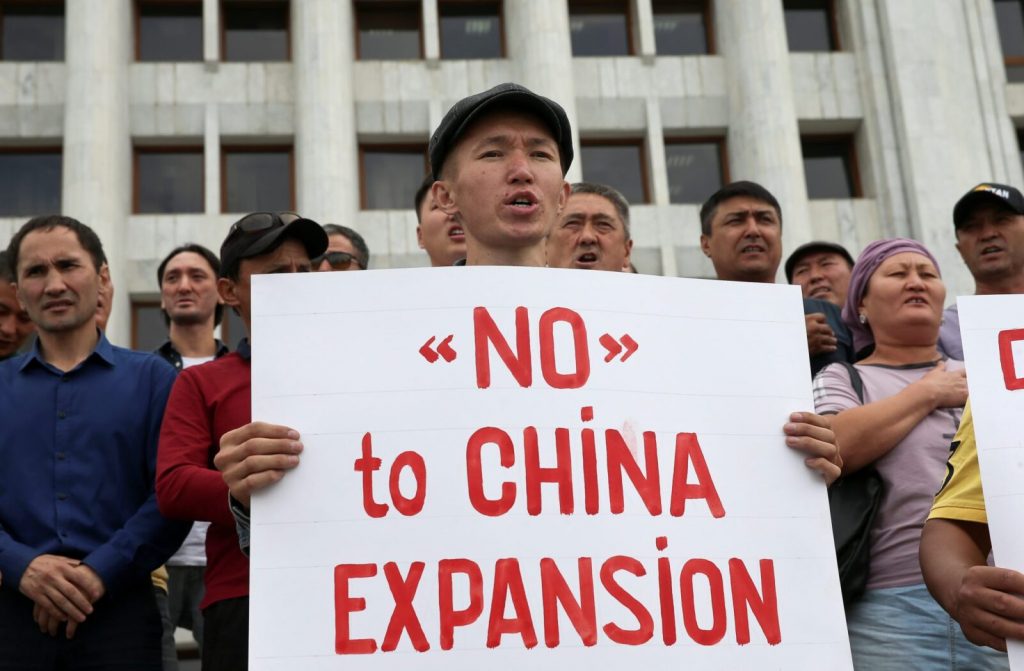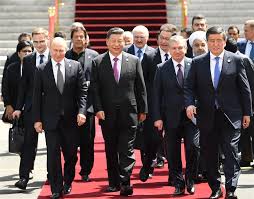Central Asia is one of the priority regions in China’s expansion strategy. Among key tasks Beijing is going to complete in the region concern energy supply, access to mineral resources, creation of an efficient transport corridor and regional security. In Central Asia, many geopolitical players have interests in common. The attitude of the local population towards the Chinese is mixed and sometimes overt hostile. This makes the task of position strengthening in the region difficult. In the meantime, Russia traditionally considers Central Asia as a zone of its own interests.
Resources. In Central Asia, as in any other regions of the world where Beijing has started implementing its expansion policy, China is primarily interested in resources. The key of them is gas. The Central Asian gas pipeline begins on the border of Turkmenistan, runs though the territory of Uzbekistan and Kazakhstan, and connects to the Chinese West-East gas pipeline in Horgos, Xinjiang Uygur Autonomous Region. In total the pipeline stretches for 1,833 km; its gas pumping capacity is 60 billion cubic meters per year. As Xinhua informs, in the first half of 2020 the Central Asia-China gas pipeline transported to the Heavenly Empire more than 19 billion cubic meters of natural gas. In total, 316 billion cubic meters of natural gas have been pumped through this trunk pipeline that was put in operation in December 2009.

Basically, what is meant here is Turkmen gas. In 2019, the State Concern ‘Turkmengaz’ supplied 31.2 billion cubic meters of gas to China; in April 2020 the supply volume reached 69 million cubic meters per day. This volume of supplies followed the conflict between Russian Gazprom and Turkmengaz resulted in changing energy export geography. Moreover, China imports gas from Kazakhstan and Uzbekistan. At the same time, the PRC can increase purchases significantly providing strengthening cooperation.
Apart from gas, the key natural resources China is interested in are zinc and lead that China extracts in Tajikistan. In this case Beijing used the tactics of creating an industrial zone for its own investments amounting to $0.5 billion. Today, the lead and zinc share import from the region to China is 21%. In addition, Chinese companies are actively mining gold in Tajikistan and intend to increase the volume to the level of 7 tons per year. China is showing interest in coal, phosphorus, tin, iron, antimony and rare metals development.
Trade and investments. From 2001 to 2019 the volume of trade between the countries of the region and China has increased from $1.5 billion to $46.5 billion. Kazakhstan and Turkmenistan have a positive trade balance with the PRC while Kyrgyzstan, Uzbekistan and Tajikistan have negative one. At the same time, the Chinese largest share in Turkmen’s export is typically 84.1% that can be reasoned by energy supplies. The PRC’s share in Kyrgyzstan’s export is the smallest one, 4.1%. In the meantime, the country heavily depends on Chinese goods – 35.4% of all imports.
China is actively trying to attach the economies of the Central Asian states. The PRC exports to the region products with a high level of added value (mechanical engineering, electrical engineering, weapons, spare parts), and imports raw materials. Chinese goods are successfully replacing analogue products from the Russia and the Western world that were typical for the region before. At the same time, the global infrastructure project ‘One Belt One Road’ plays an important role for the region. Central Asia is a strategic region for Beijing to build the most important overland trade route to the West. The designed investment system, developed infrastructure (including roads and power supply lines) and lobbied special zones (a striking example of such cooperation is creation of a free economic zone ‘Hhorgos – Eastern Gate’ in Kazakhstan to ensure the supply of Chinese goods to the West) are supposed to ensure ‘One Belt One Road’ project implementation.
According to the Ministry of Commerce of the PRC, in 2018 China’s volume of direct investments stock in five Central Asian countries reaches $14.7 billion (1.2% of all Chinese investments in Asian countries). The PRC is actively investing both in transport infrastructure and raw materials, and in industry and, more and more in agriculture. Chinese companies are investing in cement production, flour mills, pipe manufacture, textiles, plastics, etc. China shows more interest in energy projects. Here we mean not only the region’s hydropower potential development (in particular, the modernization of the region’s largest Nurek HPP, Tajikistan), but also wind power facilities. In particular, China is implementing Zhanatasskaya Wind Power Station project (Kazakhstan), the Central Asian largest project.
Security. The Central Asian region is extremely important for China in some ways. First, Beijing sees the countries of the region as a buffer zone between the PRC and Afghanistan, as a potential terrorism exporter to the territory of the PRC. In this regard, Tajikistan is extremely important for China. This was the reason why in 2016 the PRC initiated creation of a new regional consultation mechanism at the level of chiefs of general staffs from Tajikistan, Pakistan and Afghanistan. China is also investing in the security of Tajikistan, mainly, construction of bases, border posts, commandant’s offices and training centers on the Tajik-Afghan border.

Secondly, the general stabilization of the region and neutralizing the activity of Uyghur groups from the territory of neighboring states. China takes the union of Uyghur and foreign jihadist groups as a serious threat. Separatism in Xinjiang is a hot-button issue for China. That is why Beijing pays special attention to cooperation with Kazakhstan, Uzbekistan and Kyrgyzstan in this direction.
Third, ensure of the safe operation of Chinese enterprises and the transport network. Central Asia is far from a stable region. Beijing, for whom the countries of the region are extremely important in terms of resources and logistics, must protect its facilities.
The joint projects on the China-based training of officers of the Central Asian states (all countries except Turkmenistan), experience exchange, joint exercises, and the supply of Chinese equipment and weapons solve the three mentioned security tasks. As of now, experts seem to agree that in terms of security in the region China counts on Russia. However, every year the PRC increases its role in this sphere.
Interaction with Russia and other players. China’s activity in the region makes Russia pay a close attention to the current situation development because the latter used to consider Central Asia as a zone of its own interests. However, today the Kremlin cannot provide the Central Asian states’ with access to financial assistance, loans and investments to the extent that Beijing can. In addition, Russia is losing its significance in the market of energy resources and other mineral raw materials supply, the very trade that is extremely important for the economies of each and every state of the region. China fills the niche of the key investor, donor and consumer. As a result, the Central Asian regimes depend on the PRC’s financial assistance more and more. China holds back on changing the elites to lobby its interests, although the Confucius institutions go under a full head of steam in the region, especially in Kazakhstan. At this stage, it is important for China to establish long-term and reliable cooperation with the elites of Central sian states on bribery and economic relations basis.
The same situation with the West who cannot compete with the PRC. Despite its apparent interest in the region that is a key one in terms of security and rich in mineral raw materials, the Western states cannot work in the region so actively and effectively. The level of assistance and investment is not commensurate in China’s favor. Obviously, this situation is going to be intensified in the future.
The only negative point for China is spreading anti-Chinese sentiments among the population and the most elite. They perceive China as a foreign and very hostile force. That is why conflicts with Chinese workers in the countries of the region happen quite often. Russia and Turkey are mentally much closer to the elites and the population of Central Asia.

China’s efforts to create jobs and develop infrastructure do not resonate positively with the local population, as, for instance, with African countries. In addition, the Xinjiang repression and China’s policy towards the Turkic population are taken extremely negatively in all Turkic-speaking countries of the region. This very factor will be mainly focused to pursue further development of relations. We also believe that the Chinese sentiments overblown will be the main trick of the states, primarily Russia and Turkey, who do not want the Heavenly Empire strengthened in Central Asia.
Nevertheless, China will continue to expand economically and politically in the region. Given the eastern borders situation, Central Asia watches Beijing’s back. In addition, to make economic expansion into the states of Eastern and Central Europe successful, the PRC needs an effective land transport route. Although China will undoubtedly intensify the conflict with Russia and the Western world while strengthening its positions in Central Asia, the choice for active development of the region has been already made.




